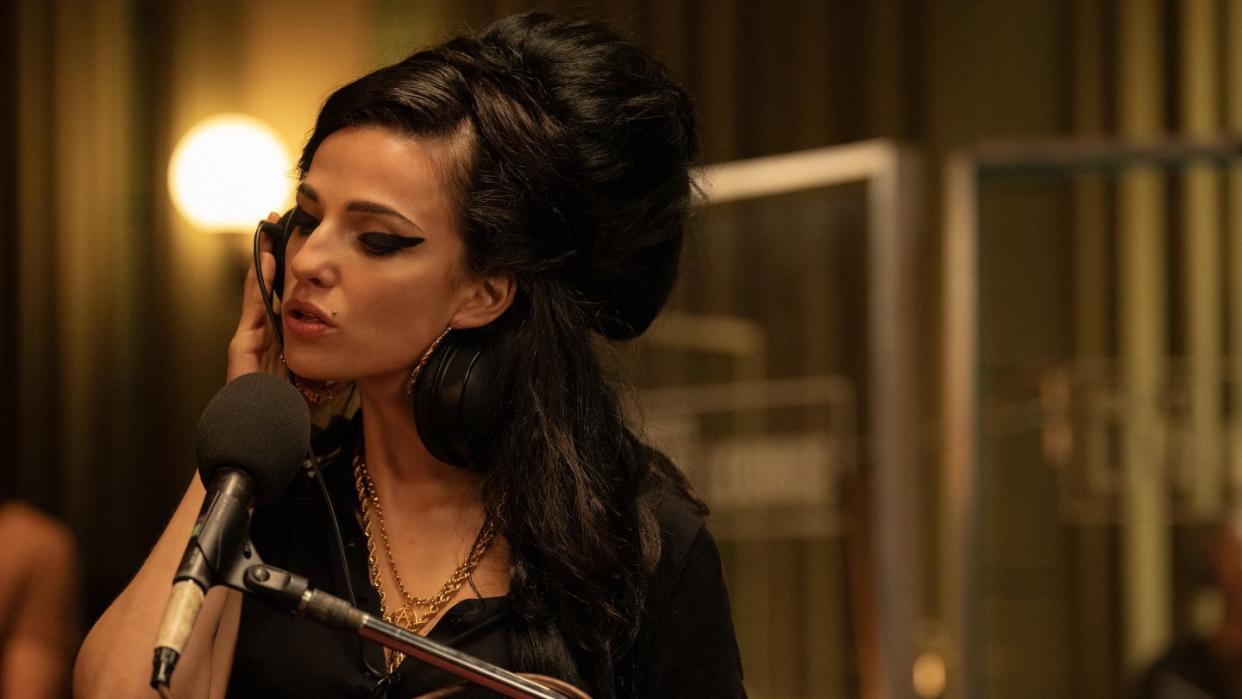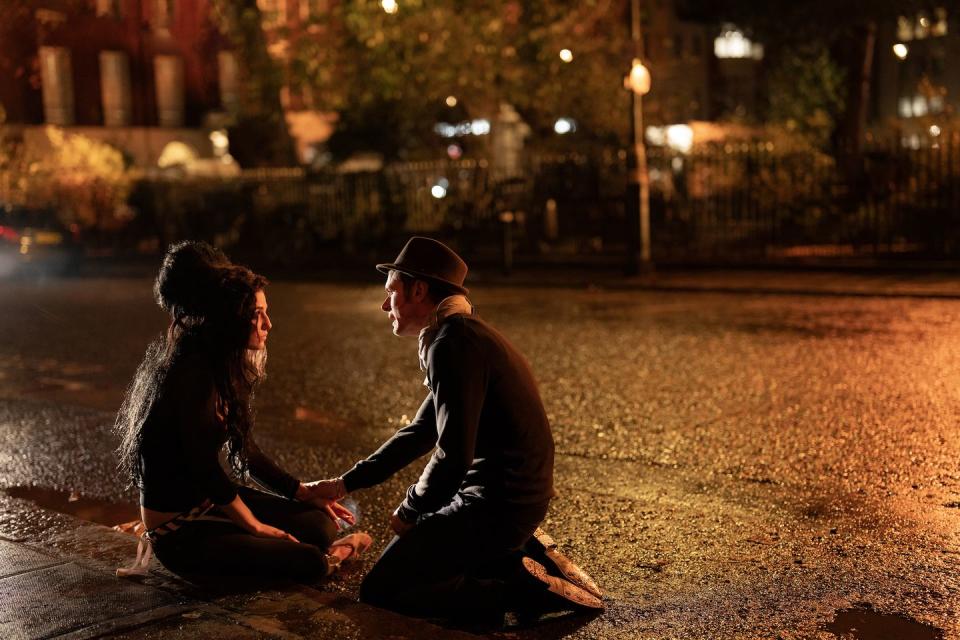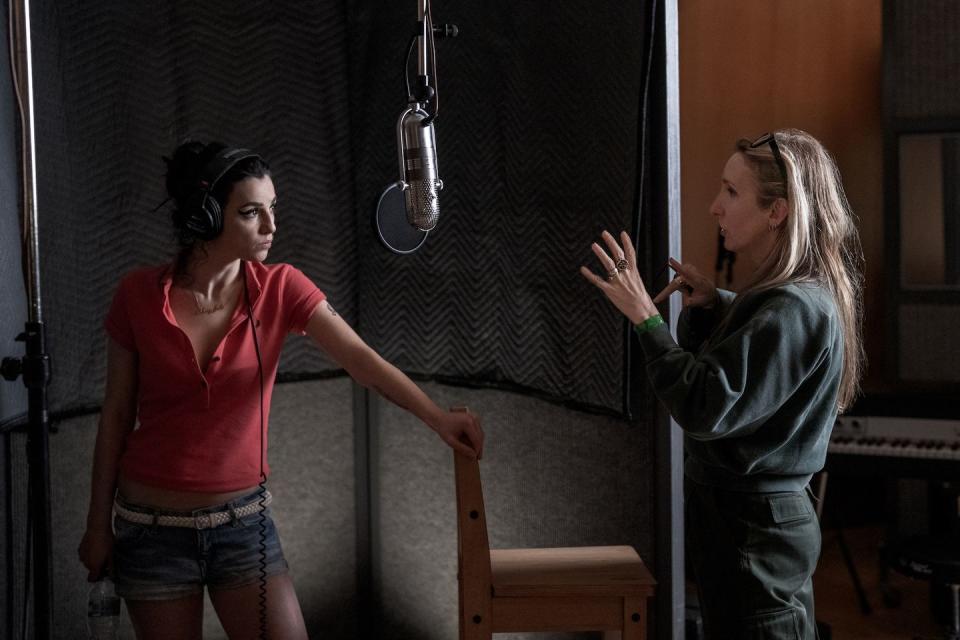Marisa Abela Wears Some of Amy Winehouse’s Actual Clothes in “Back to Black”

- Oops!Something went wrong.Please try again later.
"Hearst Magazines and Yahoo may earn commission or revenue on some items through these links."
The dialogue between a biopic and the real-life narrative can be a difficult one—especially with a story as widely known as Amy Winehouse’s. With the British soul-pop singer’s beehive hairdos, cat-eye mascara, and 2000s fashion, it would be so easy for the costumes to veer too closely into the realm of camp; on the other hand, take too many creative liberties, and you risk alienating an audience that remembers the ill-fated chanteuse as if she’d just left us yesterday. More than a decade after her death in 2011, at age 27, Winehouse remains one of the most iconic pop stars of the early ’00s: unapologetically herself, with a retro-inflected take on rock ’n’ roll before that sound became trendy. She made a huge impact on the period’s fashion and continues to have an enormous influence on pop music today.
We are pleased to report that Sam Taylor-Johnson’s Back to Black, which hits U.S. theaters this Friday, May 17, immortalizes Winehouse’s signature style seamlessly. Marisa Abela (whom you might recognize from HBO’s Industry) stars as Winehouse, in costumes brought to life by the talented PC Williams. Bazaar caught up with Williams to learn more about bringing the tragic vocal icon to life—and what she learned about Amy, and herself, along the way.
I imagine there’s a lot of pressure in getting the costuming right for a film like Back to Black. Not only was Amy Winehouse a widely known and beloved pop star, she was also known specifically for her very distinct personal style. Did you try to emulate her style exactly, did you take some liberties, or both?
I think it’s a mix. There were definitely moments when I tried to replicate her looks as close to the originals as I could. But there were times that we took liberties and designed something totally new. A lot of the decisions revolved around the script. Moments like performances are so recognizable and known that if we tried to do anything other than what was done, I think it would take the viewer out of that moment. There were times like her Glastonbury dress that we tweaked them slightly, because we were thinking about the lighting and making things more cinematic.
How did you tweak the Glastonbury dress?
The original dress is by Luella, and it’s beautiful, but the original is also incredibly heavy. We filmed the Glastonbury sequence in one day, so Marisa had to wear that dress for 12 hours, if not more. I had to reduce some of the weight. And it’s also just one shade of blue away from the original, and I added floral appliqué with some silver metallic sheeting, so under the lighting you get the sense that the florals are a different shade of blue from the dress. By creating a little more depth, you give the lights and camera more to work with.
Designers have expressed to me that the 2000s can be an odd period to costume for a film, because those clothes haven’t quite hit the costume houses yet—they’re still in people’s closets! Were you able to source much vintage for this film?
We actually had two items of Amy’s own clothes that Marisa wore. This ballet cardigan—the pink one she wears when she and [husband] Blake [Fielder-Civil] break up for the first time—and also this Pink Ladies varsity jacket with embroidery that says “Amy Woo.” It was important to me to try and have some of Amy’s original pieces.
Then there were replicas that we made of Amy’s actual pieces, too, like these black jeans with corseting details that she wore all the time. Then for the Grammys scene, we had reached out to Dolce & Gabbana, who had dressed Amy for that occasion. They no longer had the original in their archive, but they offered to remake it for us, and we were so lucky to have an exact copy. And in the Glastonbury sequence, Christian Louboutin made the exact shoes for Marisa that Amy wore that day. So we had both things from her wardrobe, and exact replicas that brands were able to make for us.
Otherwise, the majority of Marisa’s costuming was vintage. I tried to source things that I had seen Amy wearing. Two Karen Millen dresses, in particular.
When you worked with Amy’s actual clothes, what struck you about them?
How tiny they all are. They are so small. Her size was always something that was discussed, not necessarily as being diminutive, but as being otherworldly. And when you have those pieces in your hand, you’re reminded of how tiny she was in real life. I think by giving them to Marisa—who was trying to capture Amy from the inside out, and did all this work on the emotional truth of this person—it really enabled the way she wanted to perform.

What was it like working with Marisa?
As a designer, my practice is collaborative. I want the actors’ opinions, and I want them to look at my boards. At the end of the day, they need to go on the stage and become this person. If I’m costuming them in a way that doesn’t help to give something to their performance, then I’m not doing my job right. We both wanted to do Amy justice. So this wasn’t about Marisa as an actor or Sam as the director, or me as the designer—we were all there in service of Amy, so there were no egos. That created a very healthy, collaborative relationship and environment.
I can tell from your accent that you are from the U.K.! And I imagine you remember what it was like living there when Amy was at the height of her fame. How did that impact your work on this film?
I was around when Amy was around. I remember [her 2003 debut album] Frank, and I remember [her Grammy-winning hit 2006 second album] Back to Black. I remember the tabloid coverage of her life. When I think about this project, yes, there was an aspect of learning more about Amy, but I think I learned more about myself and how differently I am able to view her addictions and trauma now, as a woman who has developed more empathy. We were around at a time when the tabloids were on a mission to not separate the artist from the person, and we felt as though we could say whatever we wanted about them—even though the artist is what the person does, not necessarily who the person is. We weren’t having the conversations then like we are now about substance abuse and mental health, which we so much more freely discuss today.
Going into this project, I started to think about how far I’d grown as a person in relation to situations like that. So it was even more important for me to do Amy justice, to create costumes that enable the viewer in all moments to feel as though they are in that time. I wanted to bring an authenticity to the costumes, so it feels like we aren’t looking at costumes, we’re looking at a story.

Was there anything your actors tried to steal from set?
Actors are always trying to steal stuff from the costumes! But in a day and age when studios really want to keep everything, it’s becoming increasingly difficult for them to steal. However, if I remember correctly, we made Marisa a couple of Amy’s necklaces, so she didn’t have to steal them.
This interview has been edited for clarity and length.
You Might Also Like

